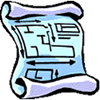

Chapter 15 Waves and Energy Transfer Review
1. The speed of an ocean wave on the coast is 42 m/s; the wavelength is 1.5 m. What is the frequency with which the wave hits the beach?
2. If the speed of sound in air is 340 m/s and the wavelength of a sound is 5.0 m, what is the frequency of the sound? What is the frequency of this sound as it moves into water?
3. What is the wavelength of a sound emitted by a tuning fork of frequency 440 vibrations per second? The speed of sound is 332 m/sec at 0.0°C and increases 0.60 m/s for each degree temperature rise. The tuning fork is at 32°C.
4. Radio waves travel at the speed of light, 3.0 x 108 m/s. What is the wavelength of a radio wave from an AM station broadcasting at a frequency of 750 kHz? Find the frequency in m and km and compare it to some familiar object of similar length.
5. A standing wave in a clothesline has 4 nodes and 3 antinodes. The clothesline is 12 m long and is vibrating at 0.50 vibrations per second. What is the speed of the wave?
6. A wave travels from one medium to another, and the wavelength decreases. What happens to the velocity and the frequency?
A. Completing Concepts
1. __________ waves require a material medium for energy transfer.
2. A(n) __________ wave causes the particles of the medium to vibrate in a direction perpendicular to the direction in which the wave is traveling.
3. __________ waves need no medium for travel.
4. A(n) __________ is a single disturbance traveling through a medium.
5. The __________ of a wave is the number of waves that pass a given point per second.
6. The __________ of a wave is the reciprocal of its frequency.
7. The __________ of a wave is the linear distance between any two corresponding points on consecutive waves.
8. The energy content of a mechanical wave is characterized by its __________.
9. __________ is the process involved when two waves meet and superimpose their amplitudes.
10. The __________ of a mechanical wave depends on the medium.
11. When waves pass from one medium into another, their __________ remains unchanged.
12. A(n) __________ wave is produced when a wave train moving in one direction meets an identical wave train moving in the opposite direction.
13. Two pulses with identical shapes but opposite displacements move toward each other in a medium. The point in the medium that is never displaced is a(n) __________.
14. __________ is the direction change of waves at the boundary between different media.
15. __________ is the bending of a wave around an obstacle.
16. __________ are undisturbed areas that are formed when two sets of waves interact with one another.
17. The __________ is a line perpendicular to a barrier at the point where an incident ray strikes the barrier.
18. When a wave is reflected from a barrier, the angle of __________ equals the angle of reflection.
B. Understanding Concepts
1. Waves provide a means of transferring
a. matter.
b. particles.
c. liquids.
d. energy
2. A 10-Hz wave has a 2-cm wavelength. The velocity of this wave is
a. 5 cm/s.
b. 8 cm/s.
c. 12 cm/s.
d. 20 cm/s.
3. A sound travels from A to B. In which direction do the particles of the medium vibrate?

4. Which of the mechanical waves represented below has the greatest energy?

5. If an incident wave makes a 20° angle with a barrier, the reflected wave makes a __________ angle with a perpendicular drawn to the barrier.
a. 10°
b. 20°
c. 50°
d. 70°
6. A is an incident ray. Which is the corresponding reflected ray?

7. If the amplitude of the reflected pulse is __________ when a wave passes from one medium to another, most of the energy has been transmitted.
a. inverted
b. erect
c. large
d. small
8. Which two points are in phase?
a. A and C
b. B and C
c A and D
d. B and D

9. Pulses are going from medium A to medium B as shown. The speed of the waves in B is greater. Which diagram best describes the pulses in B?
![]()
10. Which diagram below will lead to deconstructive interference?
![]()
11. When waves refract, the waves do not change
a. speed.
b. frequency.
c. wavelength.
d. direction.